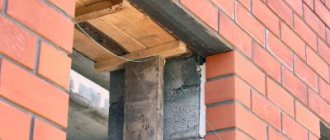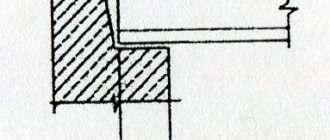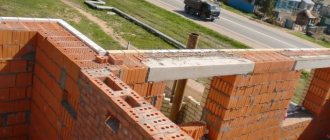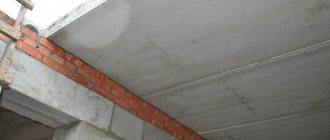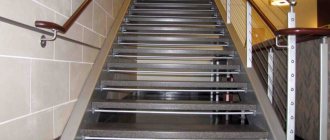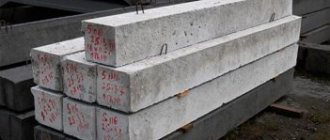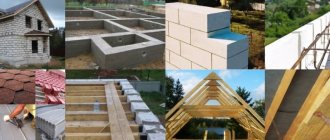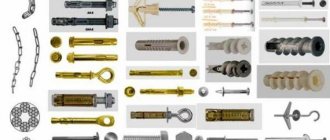Supporting lintels on a brick wall SNiP is an important component of creating door and window openings during the construction of any object. A lintel is a construction element that is used in the area of a window or door. This is an irreplaceable part that keeps the balls of bricks from moving and the wall from collapsing.
Errors in the installation of jumpers can lead to the destruction of the entire building.
What it is?
Experts call a lintel a structural element involved in covering openings, which supports most of the brickwork and distributes the load on materials (brick, mortar, floors).
The lintels are made in the form of reinforced concrete (RC) structures of the factory series, type 1.038.1-1 or 1.225-2.
Instead, you can independently make monolithic reinforced lintels that correspond to the dimensions of the opening and the distributed load.
The difference between a factory-made one and a home-made one is that a finished product can cost more than a home-made one and have a quality mark. Regardless of the manufacturing method, it is customary to distinguish the following types of jumpers:
Carriers. They are in the form of a beam with reinforcement that is used to support the floors.- Not bearing. It is necessary to distribute the load on the masonry.
- He is running. Very wide. Used for grandiose buildings.
- Pencils. Thin door frames with a partition thickness of 120 mm.
- Rigel. They are made with a shelf needed to support the structure placed above.
The most common are the first two types of structures (load-bearing and non-load-bearing), carried out using technology, in accordance with established regulatory rules. They are, for example, divided into rectangular (RB) and slabs (PP). Lintels help prevent the laid bricks from moving and causing the wall to collapse.
Purpose and load calculations
As noted above, the main function of products of this type is to cover openings in buildings or ensure correct joining of interfloor slabs.
In the construction business, the following groups are distinguished:
1. Load-bearing concrete. These are reinforced beams used to carry the load transmitted by floor slabs. Withstands weight 3400-3700 kg/m.
2. Non-load-bearing (beams). They take the load transmitted by the masonry of the wall located directly above the opening.
3. Pencils. Thin non-load-bearing; used for interior doorways. The thickness of the pencil is less than 120 mm.
4. Runs. Load bearings having large dimensions.
5. Rigel. These are purlins with a recess (shelf) that have significant weight. Crossbars are designed to support structures standing on them.
In low-rise construction, mainly the first three types of reinforced concrete products are used. The dimensions of the lintel and the maximum load on the beam are determined by specialists when creating design documentation.
When constructing small outbuildings, bathhouses, garages and similar structures, the owner can easily handle the calculations on his own. Jumpers for window and door openings corresponding to the 2PB brand are used. Their length can be from 1.03 to 2.95 m, and the cross-section has standard dimensions of 120x140 mm. The weight of beams of group 2PB is in the range of 43-125. Window ceilings can withstand a load of 200-800 kg/m, door ceilings - about 3700 kg/m.
Precast concrete factories take into account the large weight of their products. To facilitate loading, unloading and construction work, beams and slabs are provided with mounting loops or locking holes with a diameter of 30 mm. Sometimes developers make reinforced concrete beam lintels on their own. In this case, the use of the “correct” concrete and reinforcement will be a prerequisite. After all, failure to comply with the technology is fraught with the destruction of the building in a very short time. The beams are 0.3 m larger than the width of the opening.
It should be noted that lintels for buildings with factory-made brick walls have a relatively low price. Therefore, you can always buy them in the right quantity. Pouring reinforced concrete window lintels on site is unnecessary labor costs. After all, you will first need to install the formwork, then pour the concrete and let it cure. And only after that they continue laying. Ready-made PB beams will not significantly increase the cost of construction, but will significantly save time.
Dimensions
Reinforced concrete lintels have standard dimensions approved by GOST. The cross-section is determined by the corresponding marking index, for example 2ПБ-13-1п. The dimensions of this type of jumpers are 1290x120x140 mm. Depending on the type and brand of this structural element, its geometric dimensions may differ. For PB:
- height from 65 to 585 mm.
- width from 120 to 250 mm;
- length from 1 to 6 m;
Dimensions of lintels made of sheet PP:
- height from 65 to 220 mm.
- width from 380 to 510 mm;
- length from 1.1 to 3 m;
Items marked PG have the following dimensions:
- height from 290 to 585 mm.
- width from 250 to 510 mm;
- length from 1.5 to 6 m;
PF facade reinforced concrete structures have a standard width of 250 mm and the following dimensions:
- height from 140 to 290 mm.
- length from 0.8 to 4.3 m;
Information on standard lintel markings, including dimensions, weight and cost of concrete with various standard sizes, is summarized in the table:
Name Volume, m³ Weight, kg Overall dimensions, mm
| 1PB-10-1p | 0,008 | winds | 1030x120x65 |
| 1PB-13-1p | 0,01 | 25 | 1290x120x65 |
| 1PB-16-1p | 0,012 | thirty | 1550x120x65 |
| 1PP-12-3 | 0,028 | 72 | 1160x380x65 |
| 2PB-16-2p | 0,026 | 65 | 1550x120x140 |
| 2PB-10-1p | 0,017 | 43 years old | 1030x120x140 |
| 2PB-13-1p | 0,022 | 54 | 1290x120x140 |
| 2PB-16-2p | 0,026 | 65 | 1550x120x140 |
| 2PB-17-2p | 0,028 | 71 | 1680x120x140 |
| 2PB-19-3p | 0,033 | 81 years old | 1940x120x140 |
| 2PB-22-3p | 0,037 | ninety two | 2200x120x140 |
| 2PB-25-3p | 0,041 | 103 | 2460x120x140 |
| 2PB-26-4p | 0,044 | 109 | 2590x120x140 |
| 2PB-27-4p | 0,045 | 110 | 2690x120x140 |
| 2PB-29-4p | 0,048 | 120 | 2850x120x140 |
| 2PB-30-4p | 0,05 | 125 | 2980x120x140 |
| 2PG-39-31 | 0,317 | 792 | 3890x250x440 |
| 2PG-44-31 | 0,359 | 897 | 4410x250x440 |
| 2PG-48-31 | 0,391 | 977 | 4800x250x440 |
| 2PG-50-31 | 0,693 | 1733 | 5000x380x440 |
| 2PP-14-4 | 0,076 | 190 | 1420x380x140 |
| 2PP-17-5 | 0,089 | 223 | 1680x380x140 |
| 2PP-18-5 | 0,096 | 241 | 1810x380x140 |
| 2PP-21-6 | 0,11 | 280 | 2070x380x140 |
| 2PP-23-7 | 0,124 | 310 | 2330x380x140 |
| 2PP-25-8 | 0,131 | 327 | 2460x380x140 |
| 3PB-13-37p | 0,034 | 85 | 1290x120x220 |
| 3PB-16-37p | 0,041 | 102 | 1550x120x220 |
| 3PB-18-37p | 0,048 | 119 | 1810x120x220 |
| 3PB-18-8p | 0,048 | 119 | 1810x120x220 |
| 3PB-21-8p | 0,055 | 137 | 2070x120x220 |
| 3PB-25-8p | 0,065 | 162 | 2460x120x220 |
| 3PB-27-8p | 0,072 | 180 | 2720x120x220 |
| 3PB-30-8p | 0,079 | 197 | 2980x120x220 |
| 3PB-34-4p | 0,089 | 222 | 3370x120x220 |
| 3PB-36-4p | 0,096 | 240 | 3630x120x220 |
| 3PB-39-8p | 0,103 | 257 | 3890x120x220 |
| 3PP-14-71 | 0,117 | 293 | 1400x380x220 |
| 3PP-16-71 | 0,13 | 325 | 1550x380x220 |
| 3PP-18-71 | 0,151 | 378 | 1810x380x220 |
| 3PP-21-71 | 0,173 | 433 | 2070x380x220 |
| 3PP-27-71 | 0,227 | 568 | 2720x380x220 |
| ZPP-30-10 | 0,249 | 623 | 2980x380x220 |
| 4PB-30-4p | 0,104 | 259 | 2980x120x290 |
| 4PB-44-8p | 0,154 | 384 | 4410x120x290 |
| 4PB-48-8p | 0,167 | 418 | 4800x120x290 |
| 4PB-60-8p | 0,207 | 519 | 5960x120x290 |
| 4PG-30-40 | 0,301 | 753 | 2980x380x290 |
| 4PP-12-4 | 0,038 | 95 | 1160x510x65 |
| 5PB-18-27p | 0,1 | 250 | 1810x250x220 |
| 5PB-21-27p | 0,114 | 285 | 2070x250x220 |
| 5PB-25-27p | 0,135 | 338 | 2460x250x220 |
| 5PB-25-37p | 0,135 | 338 | 2460x250x220 |
| 5PB-27-27p | 0,15 | 375 | 2720x250x220 |
| 5PB-27-37p | 0,15 | 375 | 2720x250x220 |
| 5PB-30-27p | 0,164 | 410 | 2980x250x220 |
| 5PB-30-37p | 0,164 | 410 | 2980x250x220 |
| 5PB-31-27p | 0,171 | 428 | 3130x250x220 |
| 5PB-32-20p | 0,176 | 440 | 3200x250x220 |
| 5PB-34-20p | 0,185 | 469 | 3370x250x220 |
| 5PB-36-20p | 0,2 | 500 | 3630x250x220 |
| 5PP-17-6 | 0,12 | 300 | 1650x510x140 |
| 5PP-23-10 | 0,166 | 416 | 2330x510x140 |
| 6PB 35-37p | 0,254 | 630 | 3500x250x290 |
| 6PG-60-31 | 0,826 | 2065 | 5960x380x440 |
| 6PP-30-13 | 0,334 | 830 | 2980x510x220 |
| 7PP-12-3 | 0,04 | 100 | 1160x380x90 |
| 8PB-10-1p | 0,011 | 28 year | 1030x120x90 |
| 8PB-13-1p | 0,014 | 35 year | 1290x120x90 |
| 8PB-16-1p | 0,017 | 42 | 1550x120x90 |
| 8PB-17-2p | 0,018 | 45 | 1680x120x90 |
| 8PB-19-3p | 0,021 | 52 | 1940x120x90 |
| 8PP-18-71 | 0,131 | 327 | 1810x380x190 |
| 8PP-21-71p | 0,149 | 374 | 2070x380x190 |
| 8PP-23-7 | 0,168 | 421 | 2330x380x190 |
| 8PP-27-71p | 0,196 | 491 | 2720x380x190 |
| 9PB-13-37p | 0,029 | 74 | 1290x120x190 |
| 9PB-16-37p | 0,035 | 88 | 1550x120x190 |
| 9PB-18-37p | 0,041 | 103 | 1810x120x190 |
| 9PB-18-8p | 0,041 | 103 | 1810x120x190 |
| 9PB-21-8p | 0,047 | 118 | 2070x120x190 |
| 9PB-22-3p | 0,05 | 125 | 2200x120x190 |
| 9PB-25-3p | 0,056 | 140 | 2460x120x190 |
| 9PB-25-8p | 0,056 | 140 | 2460x120x190 |
| 9PB-26-4p | 0,059 | 148 | 2590x120x190 |
| 9PB-27-8p | 0,062 | 155 | 2720x120x190 |
| 9PB-29-4p | 0,065 | 162 | 2850x120x190 |
| 9PB-30-4p | 0,068 | 170 | 2980x120x190 |
| 9PP-17-6 | 0,077 | 193 | 1680x510x90 |
| 10PB 21-27p | 0,098 | 246 | 2070x250x190 |
| 10PB-25-37p | 0,117 | 292 | 2460x250x190 |
| 10PB-27-37p | 0,129 | 323 | 2720x250x190 |
Installation of floors in buildings made of foam concrete and aerated concrete
When laying hollow core slabs on a foam concrete base, its density must be taken into account. It must be at least D500. The use of ordinary hollow slabs is recommended. But they must be laid not on the foam blocks themselves, but on an annular reinforced belt (reinforced belt).
When using a concrete floor, it is mandatory to install a circular reinforced belt.
- If the support of the slab on the wall made of cellular concrete does not reach 250 mm, a distribution belt is used. It is laid along the entire length of the floor support. It is made of monolithic reinforced concrete or solid brick laid in three rows, which is reinforced with a masonry mesh. The thickness of such a belt should be at least 120 mm. The width should be 250 mm. The support depth should be the same as when building brick houses, that is, the minimum distance should be 120 mm. In tandem with floor slabs, such a belt creates a rigid structure that increases the building’s resistance to emergency impacts, temperature and shrinkage deformations.
- If the support width is more than 120 mm, then it is not necessary to use a distribution belt. An armored belt made from a ring anchor along the outer perimeter of all floor slabs will be sufficient.
When using gas silicate blocks, or aerated concrete, as they are also called, in building a house, you need to take into account that this material, despite all its similarities to foam concrete, has lower density and thermal conductivity with equal strength. And if you increase its density to the density of foam concrete, then it will be stronger. Nevertheless, the recommendations for laying hollow core slabs will be the same as for buildings made of foam concrete. The recommended support depth is the same as for brick buildings: up to 120 mm.
SNiP and GOST standards
The following basic regulatory documentation is used as a regulation for the manufacture, use and installation of jumpers, containing the entire list of necessary technical conditions:
- GOST R 57346-2016 Masonry lintels.
- GOST 948-2016 Reinforced concrete lintels for brick buildings.
- SP 70.13330.2012 and SNiP 3.03.01-87 Load-bearing and protective structures.
- GOST 948-84 Reinforced concrete lintels for brick houses.
- GOST 530-2007 “Ceramic bricks and ceramic stones”.
- SNiP dated April 12, 2002 (section 9).
- SNiP 12-03-2001 Safety of work in construction.
- SNiP 3.03.01-1987 Load-bearing and enclosing structures.
In addition to the above, when constructing internal and external brick walls, the following rules are observed:
- KGS - classifier of state standards (F, Zh3, Zh33).
- OKS - All-Russian Classifier of Building Standards;
In accordance with the listed rules of technical documentation, it is necessary to carry out the masonry manually, without niches and cavities, place the elements in accordance with the mandatory dressing and use reinforced parts in places of loading and large openings.
The selection of the bulkhead should be made based on the width of the groove, the estimated mass of the cargo, in accordance with the digital designation on the product, if it is a factory type, as well as the required series, which includes:
- 038.1-1 “Reinforced concrete lintels for buildings with brick walls. Problem 3.5-13."
- 038.1-1. “Jumping into reinforced concrete. Task 4";
- 038.1-1. “Bar lintels for residential and public buildings”;
SNiP II-22-81 “Stone structures and reinforced masonry” are also used in the construction of bridges. These standards pay special attention to the fact that reinforced concrete lintels must be equipped in such a way as to take into account the load of floors and newly laid walls (clause 6.47), which in summer will be equal to 1/3 of the span, and for the entire duration of winter work.
When erecting brick buildings, all rules must be strictly followed. Their implementation is supervised by specialists from the regional urban planning department.
Support indicator, characteristics
The concept of support is a means of solving a problem. The depth of lintels for brick walls is usually 25 cm (should not be less). In this case, above the doorway it should fall with its ends to the wall by at least 20 cm.
READ Which door is better to install in a private house as an entrance door from the street so as not to freeze
In this case, the load-bearing part for a self-supporting wall will be reduced to within 12 cm. The given indicators are taken as the maximum and minimum load-bearing depth.
Accounting for bearing indicators must comply with the technical requirements of SNiP. The choice of the required jumper in depth is determined using the designation in the tables (example, 2PB18-8) indicating the overall dimensions:
- 8 – permissible load (kg/m).
- 2 - section size 120 x 140 (mm) and strength class;
- 18 - product length (1810 - code), on both sides and maximum width - 1611 mm;
- jumper (PB - type of part);
The cross-section designations for the jumpers are as follows:
- 5 PB - 250 x 220 (mm).
- 3 PB - 120 x 220 (mm);
- 2 PB - 120 x 140 (mm);
- 4 PB - 120 x 290 (mm);
- 1 PB - 120 x 65 (mm);
Before installing the jumpers, determining the depth of the support is an important part of preparing for the work process. To do this, look at the indicators in the SNiP table and make a schematic example. The formwork is carried out according to the scheme, then the composition is poured on top of the laid structure.
Examples of overall dimensions can be found in the table:
The installation of lintels, due to their reliable sealing, requires the installation of reinforcement at the contact of the reinforced concrete structure and the brick wall.
Supporting lintels on a brick wall taking into account SNiP
Supporting lintels on a brick wall SNiP is an important component of creating door and window openings during the construction of any object. A lintel is a construction element that is used in the area of a window or door. This is an irreplaceable part that keeps the balls of bricks from moving and the wall from collapsing.
Errors in the installation of jumpers can lead to the destruction of the entire building.
Installation of lintels in stone buildings
The easiest way to decorate the top of the opening is to avoid using a lintel, increasing the height of the window all the way up to the cabinets themselves. This is not always possible, since the length of the lamp imposes its own limitations, especially for load-bearing walls; In addition, it is impossible to raise the doors to the ceiling. But you should know that between the opening and the reinforced crown there must be at least two rows of large-format blocks, or 5-7 rows of bricks, or there should be nothing.
The easiest way is to design the upper part of the opening in the walls, on which the ceilings do not rest. If the height of the masonry above the opening does not meet the requirements for self-supporting, the upper rows are reinforced with reinforcement. Between each brick of the row covering the opening, “clamps” are placed - 4 mm wire clips that protrude above the row of masonry, forming peculiar ears. Longitudinal and tie-down reinforcement is placed under them, a 10 mm rod every 10 cm of wall thickness, leaving 15-20 cm on the pillars on the sides of the opening.
It is even easier to strengthen the opening in load-bearing walls made of monolithic lightweight concrete blocks. The masonry above the opening is removed using temporary support from below. Next, a groove up to 20 cm deep and 25-30 mm thick is cut in the center of the blocks above the opening. Flat reinforcement is inserted inside - 12 mm reinforcement mesh, then the groove is filled with sand concrete. If it is obvious that such reinforcement does not meet the strength requirements, then U-shaped trays made of porous concrete are used as permanent formwork.
Reinforced concrete lintels are very important cold bridges. Their use is required only in exceptional cases, when a very large opening is provided in the load-bearing wall. These lintels are cast flush with the wall, displacing the formwork from the inside, outside and below. The lintels are reinforced in two rows, one rod with a diameter of 12 mm every 60–80 mm of wall thickness. Depending on the span length, 2-3 more reinforcing bars can be added to the bottom row of reinforcement. To prevent heat migration, a pair of EPS panels with a total thickness of 50–70 mm are installed in the center of the formwork, and the reinforcement is distributed to obtain protective layers 40 mm thick.
When installing any jumpers, it is important to be able to properly prepare the “shoulders” on which they rest. Typically, wood, solid brick or grade 300 cement mortar are used.
How to make and strengthen openings in load-bearing walls
When remodeling, it may be necessary to make an opening in a load-bearing wall. Such actions in the public sector can only be carried out in agreement with the housing stock, while private developers can act at their own peril and risk.
According to the project, the boundaries of the future opening are marked on both sides of the load-bearing wall. To ensure complete coincidence, after marking, four strictly perpendicular holes are drilled on one side in the corners of the opening and connected with lines.
Along the upper border of the opening, a horizontal trim is made about 10 mm wide and 20 cm longer than the opening in both directions. A piece of angle steel is placed into the resulting groove on each side. Its cross-section can be determined by bending calculations, but more often the embedded parts are made with great excess strength. In general, a steel angle 100x100x8 mm will be more than enough.
Above the nested corners, one hole is drilled for every 25 cm of the opening width; smooth fittings are inserted into them, through which the corners are connected to each other. The lower ligament is made with overhead steel plates 100x8 mm. After installing the lintel, the opening can be cut out and removed piece by piece.
In the lower part of the opening along the plane of each wall, two pieces of corner steel with dimensions of at least 50x50x4.5 mm must be laid. They need to be inserted into the wall at least 50 mm on each side. Vertical side corner covers are inserted between the lower and upper corners. They are usually chosen to be equivalent in size to the top frame.
On the inside, the side corners are connected with overhead plates. In the wall, the harness is secured with pins made of 12 or 14 mm profile reinforcement, which are driven into holes drilled at an angle of 45° to the wall plane every 35–40 cm. The pins are secured to the corners by welding, cut to 60–70 mm, and then tightly are bent to the plane of the frame and thoroughly scalded.
Installation
When installing lintels over openings, certain rules must be followed to avoid distortions and cracks. In private construction, elements less than 2 m long can be installed manually; for large openings, a truck crane will be required. The installation depends on the type of jumper:
- PP are less stable, so they are placed on a self-supporting wall, taking only the load of the wall on which they rest.
- PB - used in openings of load-bearing walls, as they are more resistant to bending and can withstand the load of the upper floors.
Installation is carried out after completion of the masonry, to the marks approved in the project. Before this, the reliability of the surface and the level of the removed masonry are checked.
When installing, it is important to correctly determine the depth to which the lintel is supported. This figure for a load-bearing wall must be at least 250 mm on each side, and for self-supporting walls 120 mm is sufficient. To cover the entire width of the masonry, several reinforced concrete rods are laid, but they should not extend beyond the plane of the wall.
Approximate prices and selection features
The most popular length of lintels used in residential construction is from 1.2 to 2.2 meters. The estimated cost of slab-type structures (width 38 cm) ranges from 600 to 4000 rubles. Bar lintels of similar length can be purchased at prices ranging from 250 to 1,700 rubles per piece, depending on the selected width and height.
When choosing the type of lintel above the windows, do not forget that slab lintels can only be installed in a non-load-bearing wall (on which the floor slabs do not rest). Bars can be installed in any type of enclosing structures (non-load-bearing and non-load-bearing).
The width of all manufactured reinforced concrete lintels is a multiple of the width of the masonry. Thanks to this, they are easy to choose for any object. For example, for partitions with a thickness of half a brick (12 cm) and one brick (25 cm), there are more than three dozen standard sizes of products ranging from 1 to 6 meters in length on the market. For thicker walls (1.5 bricks or more), the industry produces slab lintels.
For installation in non-load-bearing walls, it is more profitable to use slab lintels, because their width is equal to the width of the wall. In this case, you will have to use several pieces of timber beams.
When purchasing, you must take into account the support of the lintels on the wall - the main criterion for the reliability of the ceiling. If the area of the supporting part turns out to be less than the standard, then destruction of the material on which this structure rests may occur. To restore the load-bearing capacity of the pier, you will have to do the labor-intensive dismantling of the lintel, dismantling and re-laying the destroyed area.
In general, for a load-bearing brick or aerated concrete wall, the depth of embedding (support) of the lintel should be at least 25 cm. For a self-supporting wall, the size of its supporting part can be reduced to 12 cm. The lintel above the doorway should extend its ends onto the wall no less than 20 cm.
The height of the lintel is selected based on the calculated load on the opening. The developer does not need to perform complex strength calculations, since the full specification of these structures, indicating the dimensions, is contained in the design documentation. During independent construction, you should not engage in amateur activities with the selection of jumpers. It is better to contact the designers for advice.
The technology for installing lintels over openings is determined by the type of wall (load-bearing or non-load-bearing). In the first case, a powerful reinforced concrete beam is placed under the slab. Two other smaller sections are placed in the middle of the wall. The outer one goes down one row of bricks, forming a quarter.
In a non-load-bearing wall, the lintels are the same size. The outer one is lowered by a quarter, and the rest are placed at the same level.
Types of products
The lintels used for arranging brick walls are different:
- reinforced brick.
- brick,
- wood,
- metal (from channels and angles),
- reinforced concrete,
- prefabricated cell,
Reinforced concrete
Reinforced concrete products are prefabricated and monolithic. Prefabs include types such as:
rod (PB) of square or rectangular cross-section (maximum width - 250 mm, length - 1031-5960 mm);
- beam (PG), with a stepped section (protruding shelf to support the slab), width 250, 380, 510 mm, length - 1550-5950 mm.
- sheet (PP), two options for width (1 - 381 mm, 2 - 511 mm), height (141-221 mm) and length (maximum - 2981 mm);
There is also a front view of the lintel, but experts often attribute it to a steam generator, but with one small difference: the shelf is made with recesses at the ends and is clearly visible from the facade.
PP and PB are considered interchangeable. They are identical in height and length, but differ only in width. This option is used if plate-type jumpers are not available at the site.
Monolithic platbands are installed in the wall itself using formwork. At the same time, the height of the structure is calculated (1/10-1/12 of the opening dimensions) with the mandatory implementation of reinforcement (metal rods with a diameter of up to 12 mm).
The reinforcement is filled with concrete with a thickness of at least 20 mm.
Metal
Rolled steel is used for such bridges. They can create floors of 2-5 m, and they can be laid in both load-bearing and non-load-bearing parts. For brick walls, along with reinforced concrete products, this is one of the ideal options.
READ How to repair a balcony or loggia?
This product will withstand very heavy loads, as it is durable. Since such lintels can be of any length, there are no questions when constructing openings of non-standard width.
Steel angles have a number line, numbers 10-12 are especially recommended for the construction of wall structures.
Brick
Equipped with straight or curved (arc). The rectangular version is laid on the formwork, according to the rules for laying and wrapping bricks. Here you can create a wedge shape along the vertical joints of the masonry.
it is necessary to ensure that the seams are skewed and that there is no vertical displacement of the bricks. When working, it is necessary to take into account the opening width.
Curved wedge-shaped bridge with compression emphasis. Arched segments are obtained using special masonry edges, where the joints of the laid bricks are revealed.
The lifting arms in this case range from 1/6 to 1/10 of the opening width. Curved arches are arranged in a specially made circle - an arched device made of metal or plywood.
In practice, a metal arched circle is more preferable, since its shape can be easily aligned or bent.
Wooden
This type of lintel consists of good quality boards, special slabs and logs with edges and wood.
The ends of such structures are embedded into the wall at least 25 cm. Wooden lintels are easy to build with your own hands. They can withstand many years (more than 50 years), but must be insulated from moisture penetration.
Therefore, when installing them, the products must be wrapped in insulating material (polypropylene, rubber, roofing felt, polyethylene). In modern construction, such floors are used less and less, despite their cheaper cost, since reinforced concrete and metal products are more durable.
Cellular prefabricated
Such products are made from cellular, reinforced concrete and arched concrete. The height of such a lintel is 125 mm, and the depth of its support is 200-250 mm. This type of lintels in brick walls is not yet very common.
Many experts believe that this material is more suitable for a wall built from the same aerated concrete.
Reinforced brick
They are made of bricks and reinforcing metal parts - hence their name. They are created according to the same principle as bricks - straight or arched.
The fittings used to place them are 6-10 mm. Placed in formwork, filled with cement mortar. This protects them from corrosion.
There is another way of laying this type - in the form of a collapsed vault. This method can only be done by a professional.
Each of the listed types of jumpers is good in its own way. Which one is suitable in each specific case depends on the construction time (renovation of an old or new building), the additional materials used, in addition to bricks, the existing plan and structural diagram (drawing), the wishes of the customer and the material component.
Advantages of using steel angle
For the manufacture of lintels, reinforced concrete monolithic and prefabricated lintels are used - slabs, bars, beams, prefabricated products made of cellular concrete. However, for some building structures, only lintels made of rolled steel are suitable, including angle bars.
Advantages of using a corner:
- operational installation;
- the ability to lay bricks and blocks on metal lintels immediately after installing the rolled products;
- strength and reliability of metal products, subject to the correct choice of assortment, depending on the type of masonry and the planned load.
Strengthening openings in frame buildings
For frame construction, the presence of lintels at the top of the openings is strictly necessary. The requirements described below apply to both metal and wooden frames.
If the width of the opening does not exceed two stages of installation of the frame posts, the nearest elements of the side posts are connected by two horizontal crossbars, then two vertical spacers are folded together, setting the required width of the opening.
If the opening width is equal to three or more distances between the frame posts, it is decorated in the same way with crossbars. To provide additional support for the short struts above the opening, they are unloaded onto the adjacent ones using diagonal struts running from the center outward. In all cases, the cross-section of the crossbars should not be less than the dimensions of the rack-mount elements of the frame.
If the opening is more than five times as wide as the distance between the posts, the verticals closest to it should be doubled. The internal pair is connected to each other by a horizontal jumper, and the external one is the same, but higher than half the height of the opening. The space between two horizontal beams is filled with a diagonal stiffening grid according to the principle of a ceiling truss.
Support nodes
The unit for supporting the floor slab on a brick wall is a capital element of the building for its strong fixation.
When creating a node, the following conditions must be met:
- by welding, the reinforcing rods of the plates and armored belts are rigidly connected to each other;
- to reduce heat loss, use special liners that cover empty holes;
- thermal insulation is performed between the ceiling and the masonry;
- The ends of the slab should not be closely adjacent to the masonry.
To make a supporting element, when the bottom of the building’s ceiling is reached, masonry is made only from the outside to form a niche for the slab. Additionally, the following recommendations should be taken into account:
- If the product is mounted on half a brick (12 cm), then add 1 cm for the niche. This is done so that the overlapping element does not rest against the brick layer.
- A cement-sand mixture is laid on the brick, the quality of which is the same as the masonry mortar.
- The end voids are tightly closed with concrete liners so that the ceiling is not destroyed during further construction of the wall from above.
Reinforcement of reinforced concrete products
The choice of reinforcement type and rod diameter depends on the type of lintel. According to GOST, for reinforced concrete lintels used in private construction, prestressed reinforcement with a diameter of 6 to 8 mm is used. For floors designed for heavy loads, larger diameter reinforcement is used.
For longitudinal reinforcement use:
- anti-stress armor is made of A400 or A500 steel, AT-IIIC hardened steel, B500 or BP500 wire.
- hardened steels such as At800 or At600S, hot-rolled rods of class A800 or A600 can be used as prestressed reinforcement;
For the manufacture of transverse parts of the reinforcing frame, hot-rolled steel A240, A400, A500, reinforcing threads B-500, VR500 are used. When manufacturing bar or sheet elements of standard sizes, it should be taken into account that the flat steel frame is 12 cm thick, and the spatial frame is 25 cm thick.
When stressing the reinforcement, it is necessary that the actual deviations in reinforced concrete do not exceed the values indicated in the table:
Name Geometric parameter Maximum deviation, mm
| Deviation from linear size | Length: up to 2500 inclusive from 2500 to 4000 inclusive more than 4000 Width and height: Sizing position: protrusions, dents and holes built-in products: in architrave plan from architrave plan | ± 6 ± 8 ± 10 ± 5 5 3 |
| Deviation from straightness | Straightness of the front surface profile: length up to 2500 to a given length 1000 length from 2500 to 4000 along the entire length more than 4000 lengths along the entire length | 3 ± 3 ± 4 |
Before pouring, steel reinforcing bars are laid along the formwork and secured with wire, forming a strong reinforcing mesh. The cells of the resulting frame should be 20-50 mm, this is the optimal indicator for ensuring the necessary strength.
Load of a reinforced concrete floor slab on a wall
According to SNiP regulations, it is allowed for floor slabs to rest on walls on two, three or four sides. The choice of method directly depends not only on the design of the reinforcing frame, but also on the type of reinforced concrete products. For example, for products of the PB brands, the use of two sides of the support is allowed, while PCs are produced for different options for using the number of supports.
For 2 supports
In this case, the floor slab is supported on the wall in two places. Taking into account the reinforcement in the longitudinal direction, the product is laid with narrow sides.
For 3 supports
This option implies the presence of three points of support, that is, we are talking about U-shaped spans, usually located in the corners of buildings. The ends of the slabs for such use are subject to reinforced reinforcement.
For 4 supports
As a rule, reinforced concrete products of this type are used in complex structures that require optimal distribution of increased loads, as well as when additional superstructures are erected. Taking into account the possibility of support at 4 points, reinforcement is carried out at each of the four ends.
Types and markings of jumpers
According to GOST 948-2016 standards, the industry offers several main types of reinforced concrete lintels:
- The facade (FF) closes the openings to the outside due to the protrusion of the block.
- Sheets (PP) consist of several rods and are more than 250 mm wide and have a rectangular cross-section.
- L-shaped (PG) lintels are made with a quarter cut along the entire length, which allows them to be used at the junction of floor slabs.
- A square (PB) with one side of the section no more than 25 cm. Depending on the brand of the product, its length can vary from 1030 to 5960 mm. The standardized beam partition is available in 10 lengths, each of which has two subtypes with different weights and reinforcement systems.
In special cases, the standards allow the use of sloping edges and ends, but the area of the reference plane may be slightly reduced. To fill concrete lintels, concrete grade M250 (B20) and higher is used.
As with any other reinforced concrete product, the marking of lintels is developed in accordance with the current GOST. These designations are an alphanumeric set and are applied to one of the sides of each product:
- the index “p” indicates the presence of hinges for assembly, protruding fittings for fastening ledges and balconies are indicated by the letter “a”, lifting eyes or recessed elements are indicated by the letter “b”.
- the number after the letter indicates the length in decimeters;
- the following figure shows the load that the element can withstand, in kN/m;
- the combination of letters PP or PB does not indicate the type of section of the element;
- in the figure at the beginning the serial number of the cross section is indicated;
- index responsible for the material of the reinforcement cage used;
Any reinforced concrete lintel, rod or slab is reinforced with a reinforcing cage. These structures use different types of longitudinal and transverse reinforcement; the quality of materials is regulated by GOSTs.
Types of plates and rods have their own standard dimensions specified in the regulatory documentation. When choosing, you can use the following scheme:
For example, the technical documentation indicates that load-bearing lintels with reinforced concrete beams 3PB-25-8At800p are used in window openings. This means that it is necessary to install elements with a cross-section of 12 by 22 cm, a length of 246 cm, a design load of 8 kN/m, a metal frame made of AT800 steel, with mounting loops.
Options for partitions have less strength, and for arched doors and windows this structural element is calculated separately, depending on the radius of curvature and other characteristics.
Reinforced concrete as the most popular material for lintels
Reinforced concrete parts are combined with each other to create a reliable lintel.
However, to manufacture it, you should know that there are different sizes of reinforced concrete lintels, differing in name:
- PB is a product in the form of a beam, usually no more than 250 mm wide, and the length varies depending on the product labeling and can range from 1 to almost 6 m;
- PP - the product is a tiled surface, and its width already exceeds 250 mm; it is made by fastening several beams;
- PG - products of this marking are produced in the form of beams that have a special groove in their design, called a quarter; PG is used for arranging reliable connections at slabs used for flooring;
- PF is a variant of a reinforced concrete product used on the facade of a building, and “covers” the PG and its recesses.
Some people prefer to make reinforced concrete themselves by constructing formwork, inserting reinforcement parts and filling it all with concrete mixture. However, to create support above window openings, it is recommended to use factory-made lintels. At some factories it is possible to order individual forms for the window opening.
As for the minimum support for lintels, it is at least 250 mm on a brick wall, and for installation on partitions - at least 200 mm.
How to choose?
It is better to leave the choice of a suitable sweater to professionals. They will evaluate the type of wall, design features and characteristics of the constituent elements that will need to be laid in one direction to achieve the desired span width.
When choosing, take into account the amount of load that the jumper will have to withstand and the quality of the material. So, for example, if the lintel is concrete, the grade of concrete is taken into account. The same goes for bricks and fittings (steel grade).
Also pay attention to the design edge, the use of SNiP (support depth), and the parameters of the finished product specified by the manufacturers. Pay special attention to the folds of the material. For example, metal supports should generally not bend more than 1/200 of their specified length.
Below is an example of the correct choice of jumper (in this case metal:
Calculation example
The correct calculation of the lintel for the opening is carried out using an exact or simplified calculation. To avoid mistakes, you must use the indicators of the SNiP tables.
Simplified
Here it is customary to first determine the load acting on the wall, and then determine the maximum bending moment acting on the cross section.
Loads per linear meter are determined depending on the weight of the masonry: q1 = pxbxh, where:
- h is the height of the masonry.
- b - wall thickness,
- p in kg/m3 - the density of the material from which the partition is made (this also includes masonry mortar),
For example, with the proposed opening for a brick partition, the width is 1 m and the thickness is ½ of a brick product, so the total design load will be: q = 1.1 x 142.5 = 157 (kg / m).
When determining operations for installing lintels in brick walls, pay attention to masonry in summer or winter, as specified in SNiP “Stone structures and reinforced masonry” in paragraph 6.47.
Building up the structure
It is allowed to support the lintels on a brick wall SNiP by building up the structure on site. For this it is important to use formwork, i.e. box It must be selected in such a way that the lower part of the formwork or the bottom completely follows the dimensions of the opening. The formwork is nailed to the side parts, which should extend at least 20-25 cm into the structure. The side of such a structure is limited by brickwork. To ensure an accurate fit of the board to the wall, experienced builders recommend mounting the bricks in such a way that they protrude half the brick on both sides.
The box has small protrusions for installation, the board is attached and lies perfectly flat. Several rows of bricks are placed at the bottom of the structure (to hold the bottom of the box). This technology ensures strong and reliable fixation of the formwork. Then the elements are placed in the box and filled with solution.
For strong, reliable coupling of reinforcement elements, they can be placed in a joint ball of mortar from the side of the side stop or between the bricks. At the final stage, the side protruding bricks can be cut off using a grinder or safely used to tie up window decor parts.
The construction of one-story, small houses does not require massive reinforced concrete structures. Therefore, elements are selected for them from ready-made metal objects. More often they use a channel, ordinary reinforcement bars, a metal corner or strips. These supports are very lightweight, easy to use and quick to install.
Before installing such structures, it is important to correctly calculate the jumpers. There is a risk of the structure sagging, which could jam or destroy the window.
According to SNiP standards, such metal supports can bend no more than 1/200 of the length of the support itself.
To correctly calculate such installations, you will need the help of a specialist. If the calculation of the jumper is carried out independently, it is recommended that you familiarize yourself with the SNiP methods.
Materials and tools for the device
To install lintels in brick walls, you will need the following consumables and tools:
- composition for concrete, ready-made or separately: cement, sand, crushed stone, water, slag.
- edged boards of the same thickness, with metal or wooden supports;
- spatula, putty, brushes, shovels, bucket for mortar;
- metal corners, self-tapping screws, reinforcing mesh or metal rods, large-headed nails, knitting wire;
- construction hammer, hacksaw, electric drill, screwdriver;
- set of installation accessories;
- polyethylene film, roofing felt;
Gloves, coveralls, rags, brushes and a concrete "leveler" may be useful separately to ensure that the poured mortar compacts well during spreading, filling the pores of the wall and the formwork attached to the surface.
Minimum support of lintels on a brick wall
A lintel in a building project is a short concrete, metal or wood floor over openings on which bricks or other blocks are laid. Correct installation of lintels on brick walls involves calculating the load vectors from supporting forces. If the weight of the lintel and the building materials laid on it puts pressure on the wall, then prefabricated reinforced concrete structures are used. In the absence of loads on the wall, as well as when the width of the installation openings is ≤ 2 meters, the lintels are made non-load-bearing - from light reinforced concrete slabs or bricks, laid in rows on a high-strength mortar and with the laying of reinforcement elements on which the lower brick row rests. In order to diversify architectural elements, not ordinary brick lintels, but structures in the form of a wedge element can be used, and arched lintels can be built over large spans. Arched brickwork is installed for the ceiling system in vaulted structures.
